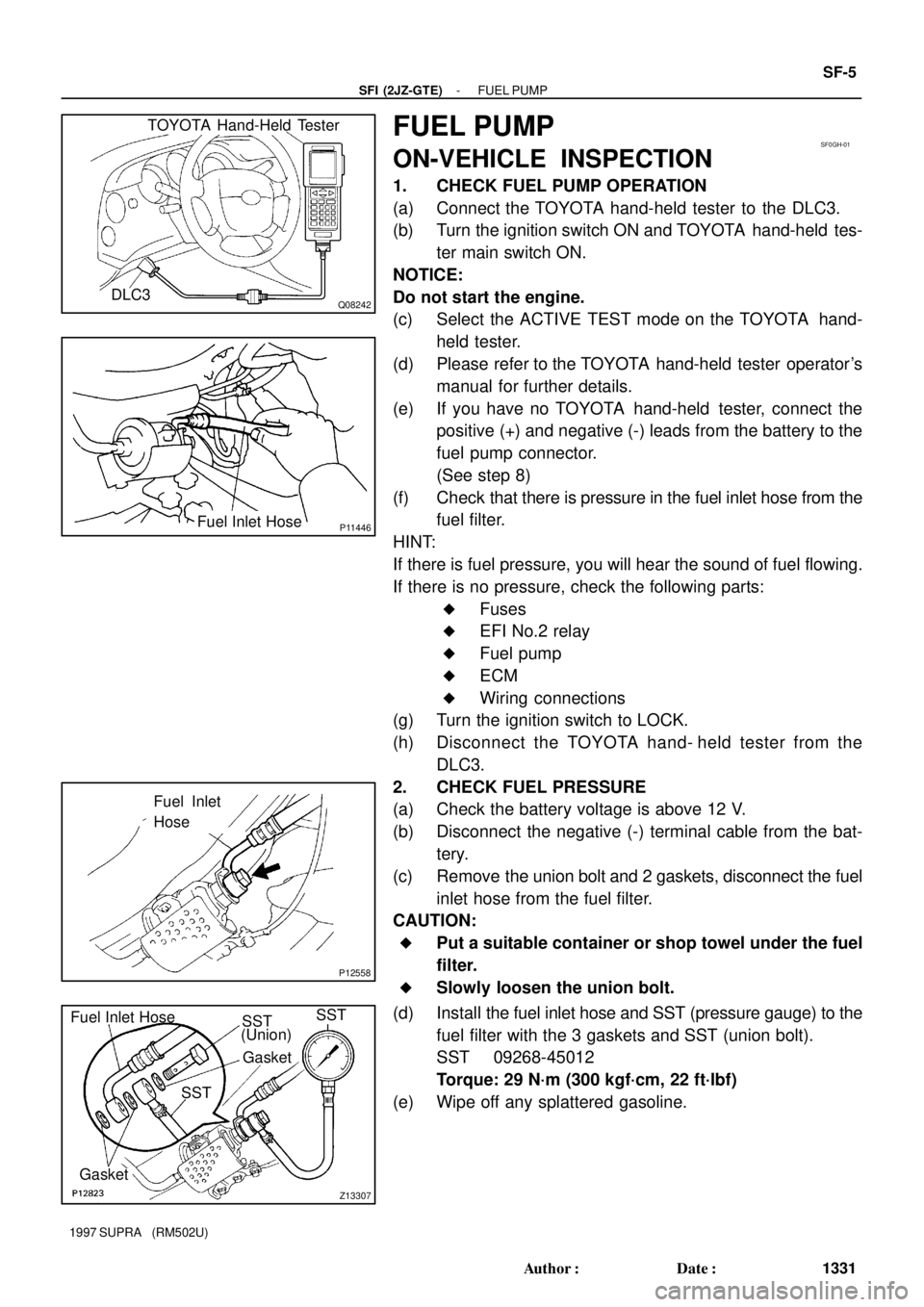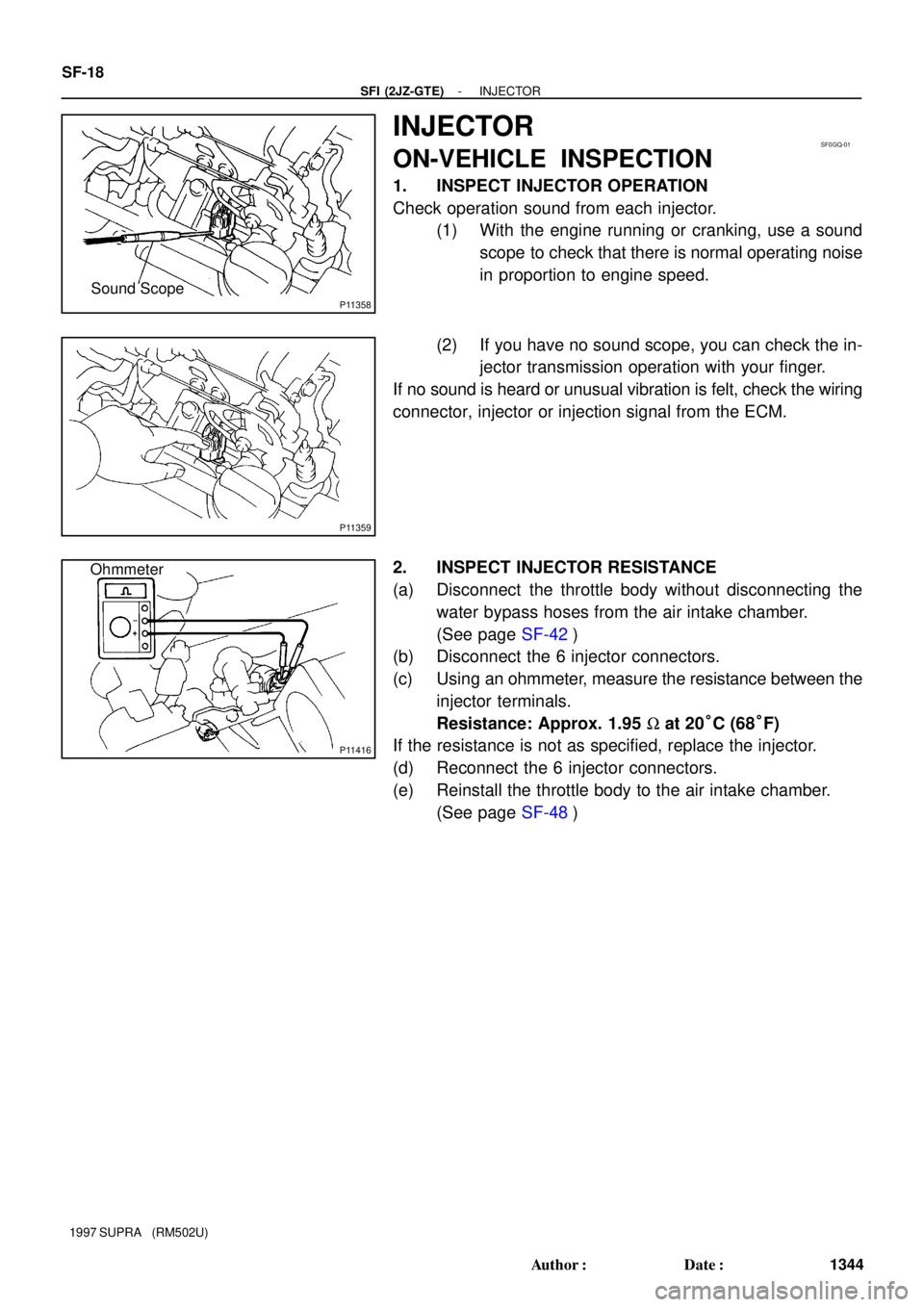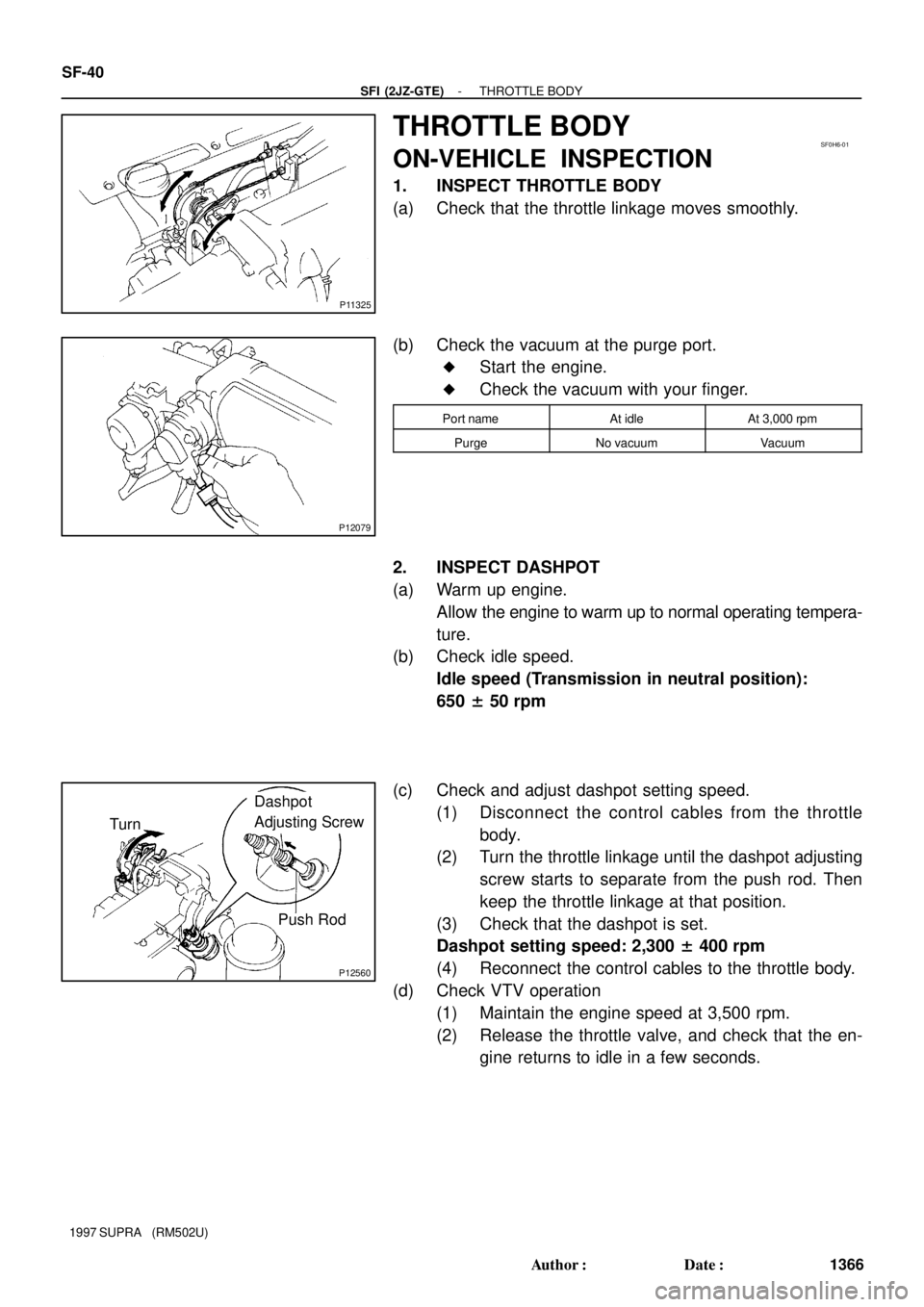Page 1464 of 1807

Q08242
TOYOTA Hand-Held Tester
DLC3
P11445
Fuel Return
Hose
Pinch SF-4
- SFI (2JZ-GTE)SFI SYSTEM
1330 Author�: Date�:
1997 SUPRA (RM502U)
(e) Check that there are no fuel leaks after doing mainte-
nance anywhere on the fuel system.
(1) Connect the TOYOTA hand- held tester to the
DLC3.
(2) Turn the ignition switch ON and TOYOTA hand-
held tester main switch ON.
NOTICE:
Do not start the engine.
(3) Select the active test mode on the TOYOTA hand-
held tester.
(4) Please refer to the TOYOTA hand-held tester oper-
ator 's manual for further details.
(5) If you have no TOYOTA hand-held tester, connect
the positive (+) and negative (-) leads from the bat-
tery to the fuel pump connector.
(See page SF-5)
(6) Pinch the fuel return hose.
The pressure in the high pressure line will rise to
approx. 392 kPa (4 kgf/cm
2, 57 psi). In this state,
check to see that there are no leaks from any part
of the fuel system.
NOTICE:
�Always pinch the hose.
�Avoid bending as it may cause the hose to crack.
(7) Turn the ignition switch to LOCK.
(8) Disconnect the TOYOTA hand-held tester from the
DLC3.
Page 1465 of 1807

Q08242
TOYOTA Hand-Held Tester
DLC3
P11446Fuel Inlet Hose
P12558
Fuel Inlet
Hose
SF0GH-01
Z13307
Fuel Inlet HoseSST
Gasket
SSTSST
Gasket(Union)
- SFI (2JZ-GTE)FUEL PUMP
SF-5
1331 Author�: Date�:
1997 SUPRA (RM502U)
FUEL PUMP
ON-VEHICLE INSPECTION
1. CHECK FUEL PUMP OPERATION
(a) Connect the TOYOTA hand-held tester to the DLC3.
(b) Turn the ignition switch ON and TOYOTA hand-held tes-
ter main switch ON.
NOTICE:
Do not start the engine.
(c) Select the ACTIVE TEST mode on the TOYOTA hand-
held tester.
(d) Please refer to the TOYOTA hand-held tester operator's
manual for further details.
(e) If you have no TOYOTA hand-held tester, connect the
positive (+) and negative (-) leads from the battery to the
fuel pump connector.
(See step 8)
(f) Check that there is pressure in the fuel inlet hose from the
fuel filter.
HINT:
If there is fuel pressure, you will hear the sound of fuel flowing.
If there is no pressure, check the following parts:
�Fuses
�EFI No.2 relay
�Fuel pump
�ECM
�Wiring connections
(g) Turn the ignition switch to LOCK.
(h) Disconnect the TOYOTA hand- held tester from the
DLC3.
2. CHECK FUEL PRESSURE
(a) Check the battery voltage is above 12 V.
(b) Disconnect the negative (-) terminal cable from the bat-
tery.
(c) Remove the union bolt and 2 gaskets, disconnect the fuel
inlet hose from the fuel filter.
CAUTION:
�Put a suitable container or shop towel under the fuel
filter.
�Slowly loosen the union bolt.
(d) Install the fuel inlet hose and SST (pressure gauge) to the
fuel filter with the 3 gaskets and SST (union bolt).
SST 09268-45012
Torque: 29 N´m (300 kgf´cm, 22 ft´lbf)
(e) Wipe off any splattered gasoline.
Page 1466 of 1807

Q08242
TOYOTA Hand-Held Tester
DLC3
P12563
Disconnect
Plug SF-6
- SFI (2JZ-GTE)FUEL PUMP
1332 Author�: Date�:
1997 SUPRA (RM502U)
(f) Connect the TOYOTA hand-held tester to the DLC3.
(See step 1 in check fuel pump operation (a) to (e).)
(g) Reconnect the negative (-) terminal cable to the battery.
(h) Turn the ignition switch ON.
(i) Measure the fuel pressure.
Fuel pressure:
226 - 275 kPa (2.3 - 2.8 kgf/cm
2, 33 - 40 psi)
If pressure is high, replace the fuel pressure regulator.
If pressure is low, check the following parts:
(1) Fuel hoses and connections
(2) Fuel pump
(3) Fuel filter
(4) Fuel pressure regulator
(j) Remove the TOYOTA hand-held tester from the
DLC3.
(k) Start the engine.
(l) Disconnect the vacuum sensing hose from the fuel pres-
sure regulator, and plug the hose end.
(m) Measure the fuel pressure at idle.
Fuel pressure:
226 - 275 kPa (2.3 - 2.8 kgf/cm
2, 33 - 40 psi)
(n) Reconnect the vacuum sensing hose to the fuel pressure
regulator.
(o) Measure the fuel pressure at idle.
Fuel pressure:
167 - 216 kPa (1.7 - 2.2 kgf/cm
2, 24 - 31 psi)
If pressure is not as specified, check the vacuum sensing hose
and fuel pressure regulator.
(p) Stop the engine.
(q) Check that the fuel pressure remains as specified for 5
minutes after the engine has stopped.
Fuel pressure:
147 kPa (1.5 kgf/cm
2, 21 psi) or more
If pressure is not as specified, check the fuel pump, pressure
regulator and/or injectors.
(r) After checking fuel pressure, disconnect the negative (-)
terminal cable from the battery and carefully remove the
SST to prevent gasoline from splashing.
SST 09268-45012
(s) Reinstall the fuel inlet hose to the fuel filter with 2 new gas-
kets and the union bolt.
Torque: 29 N´m (300 kgf´cm, 22 ft´lbf)
(t) Reconnect the negative (-) terminal cable to the battery.
(u) Check for fuel leaks.
3. TAKE OUT FLOOR CARPET
4. REMOVE SPARE WHEEL COVER
5. REMOVE SPARE WHEEL
6. REMOVE SERVICE HOLE COVER
7. DISCONNECT FUEL PUMP & SENDER GAUGE CON-
NECTOR
Page 1477 of 1807

P11358Sound Scope
SF0GQ-01
P11359
P11416
Ohmmeter SF-18
- SFI (2JZ-GTE)INJECTOR
1344 Author�: Date�:
1997 SUPRA (RM502U)
INJECTOR
ON-VEHICLE INSPECTION
1. INSPECT INJECTOR OPERATION
Check operation sound from each injector.
(1) With the engine running or cranking, use a sound
scope to check that there is normal operating noise
in proportion to engine speed.
(2) If you have no sound scope, you can check the in-
jector transmission operation with your finger.
If no sound is heard or unusual vibration is felt, check the wiring
connector, injector or injection signal from the ECM.
2. INSPECT INJECTOR RESISTANCE
(a) Disconnect the throttle body without disconnecting the
water bypass hoses from the air intake chamber.
(See page SF-42)
(b) Disconnect the 6 injector connectors.
(c) Using an ohmmeter, measure the resistance between the
injector terminals.
Resistance: Approx. 1.95 W at 20°C (68°F)
If the resistance is not as specified, replace the injector.
(d) Reconnect the 6 injector connectors.
(e) Reinstall the throttle body to the air intake chamber.
(See page SF-48)
Page 1486 of 1807

Q08242
TOYOTA Hand-Held Tester
DLC3
P12548
SST (Wire)
Connect
P12549
- SFI (2JZ-GTE)INJECTOR
SF-27
1353 Author�: Date�:
1997 SUPRA (RM502U)
(i) Connect the TOYOTA hand-held tester to the DLC3.
(j) Turn the ignition switch ON and TOYOTA hand-held tes-
ter main switch ON.
NOTICE:
Do not start the engine.
(k) Select the active test mode on the TOYOTA hand-held
tester.
(l) Please refer to the TOYOTA hand-held tester operator's
manual for further details.
(m) If you have no TOYOTA hand-held tester, connect the
positive (+) and negative (-) leads from the battery to the
fuel pump connector.
(n) Connect SST (wire) to the injector and battery for 15 se-
conds, and measure the injection volume with a gra-
duated cylinder. Test each injector 2 or 3 times.
SST 09842-30060
Injection volume:
111 - 141 cm
3 (6.8 - 8.6 cu in.) per 15 sec.
Difference between each injector:
10 cm
3 (0.6 cu in.) or less
If the injection volume is not as specified, replace the injector.
2. INSPECT LEAKAGE
(a) In the condition above, disconnect the tester probes of
SST (wire) from the battery and check the fuel leakage
from the injector.
SST 09842-30060
Fuel drop:
One drop or less per minutes
(b) Turn the ignition switch to LOCK.
(c) Disconnect the negative (-) terminal cable from the bat-
tery.
(d) Remove the SST.
SST 09268-41046
(e) Reconnect the fuel inlet hose to the fuel filter with 2 new
gaskets and the union bolt.
Torque: 29 N´m (300 kgf´cm, 22 ft´lbf)
(f) Reconnect the fuel return hose to the fuel return pipe.
(g) Remove the 6 bolts, 3 injector holders and 6 insulators.
(h) Disconnect the TOYOTA hand- held tester from the
DLC3.
Page 1496 of 1807

P11325
SF0H6-01
P12079
P12560
Turn
Dashpot
Adjusting Screw
Push Rod SF-40
- SFI (2JZ-GTE)THROTTLE BODY
1366 Author�: Date�:
1997 SUPRA (RM502U)
THROTTLE BODY
ON-VEHICLE INSPECTION
1. INSPECT THROTTLE BODY
(a) Check that the throttle linkage moves smoothly.
(b) Check the vacuum at the purge port.
�Start the engine.
�Check the vacuum with your finger.
Port nameAt idleAt 3,000 rpm
PurgeNo vacuumVacuum
2. INSPECT DASHPOT
(a) Warm up engine.
Allow the engine to warm up to normal operating tempera-
ture.
(b) Check idle speed.
Idle speed (Transmission in neutral position):
650 ± 50 rpm
(c) Check and adjust dashpot setting speed.
(1) Disconnect the control cables from the throttle
body.
(2) Turn the throttle linkage until the dashpot adjusting
screw starts to separate from the push rod. Then
keep the throttle linkage at that position.
(3) Check that the dashpot is set.
Dashpot setting speed: 2,300 ± 400 rpm
(4) Reconnect the control cables to the throttle body.
(d) Check VTV operation
(1) Maintain the engine speed at 3,500 rpm.
(2) Release the throttle valve, and check that the en-
gine returns to idle in a few seconds.
Page 1497 of 1807
Z13303
Disconnect
PlugThrottle
Opener
Adjusting
Screw
- SFI (2JZ-GTE)THROTTLE BODY
SF-41
1367 Author�: Date�:
1997 SUPRA (RM502U)
3. INSPECT THROTTLE OPENER
(a) Warm up engine
Allow the engine to warm up to normal operating tempera-
ture.
(b) Check idle speed
Idle speed (Transmission in neutral position):
650 ± 50 rpm
(c) Check throttle opener setting speed
(1) Disconnect the throttle opener vacuum hose from
the throttle body, and plug the throttle body port.
(2) Maintain the engine speed at 2,500 rpm.
(3) Release the throttle valve.
(4) Check that the throttle opener is set.
Throttle opener setting speed: 1,500 ± 200 rpm
(5) Adjust the throttle opener setting speed by turning
the throttle opener adjusting screw.
(6) Reconnect the throttle opener vacuum hose to the
throttle body.
Page 1504 of 1807
P11385
P11417
Ohmmeter
S4
S3 B1S2 B2
S1
SF0HB-01
- SFI (2JZ-GTE)IDLE AIR CONTROL (IAC) VALVE
SF-49
1375 Author�: Date�:
1997 SUPRA (RM502U)
IDLE AIR CONTROL (IAC) VALVE
ON-VEHICLE INSPECTION
1. INSPECT IAC VALVE FOR OPERATING SOUND
Check that there is a clicking sound immediately after stopping
the engine.
If operation is not as specified, check the IAC valve, wiring and
ECM.
2. INSPECT IAC VALVE RESISTANCE
NOTICE:
ºColdº and ºHotº in these sentences express the tempera-
ture of the coils themselves.
ºColdº is from -10°C (14°F) to 50°C (122°F) and ºHotº is
from 50°C (122°F) to 100°C (212°F).
Using an ohmmeter, measure the resistance between the ter-
minals (B1 (or B2) to others).
Resistance:
Cold15 - 25 W
Hot20 - 30 W
If resistance is not as specified, replace the IAC valve.